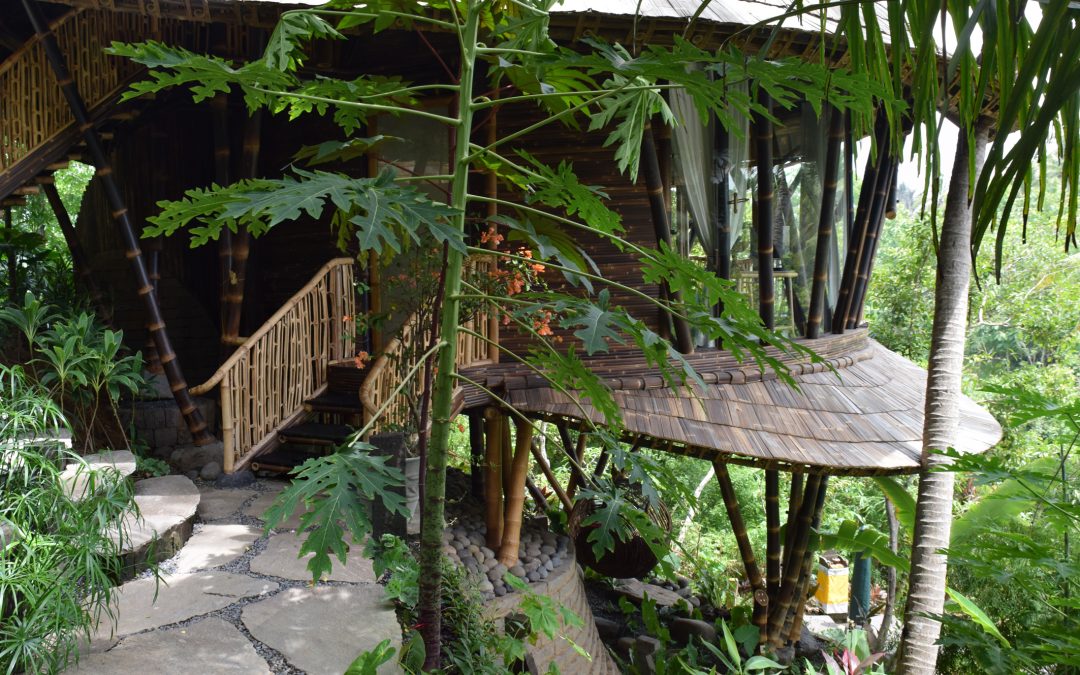BALI, Indonesia—How do you build a future out of grass? On the Indonesian island of Bali, one organization has set out to do just that. Ibuku, an architecture and furniture design firm based outside of Denpasar, Bali’s capital, is using Dendrocalamus asper bamboo—or petung in Balinese—to construct Green Village. I had the chance to visit this innovative.
The living room of ‘Temple House’ a home constructed in the Green Village, a neighborhood on the island of Bali dedicated to building homes almost entirely out of bamboo. Photos by Ari Beser
BALI, Indonesia—How do you build a future out of grass? On the Indonesian island of Bali, one organization has set out to do just that. Ibuku, an architecture and furniture design firm based outside of Denpasar, Bali’s capital, is using Dendrocalamus asper bamboo—or petung in Balinese—to construct Green Village. I had the chance to visit this innovative new community while on leave from my Fulbright National Geographic Fellowship in Japan.
Green Village was inspired by the design of Green School, an eco friendly academy founded by John Hardy, the father of Elora Hardy, Ibuku’s founder and creative director. Ibu in Balinese means Mother, and ku means mine. Ibuku’s philosophy is similar to Green School’s desire to maintain a relationship with Mother Earth and the environment and delicate ecosystem that surrounds them.
According to a statement by Ibuku, “Bamboo is a flexible and tensile material with the strength equivalent to steel. We account for the flexibility in the engineering process and work to ensure our bamboo maintains its integrity over time. Bamboo is plentiful in river valleys throughout Asia, and the clumps regenerate each year. Bamboo is ready for use as a building material at age 3-5 years.”
While bamboo has been used worldwide in construction and craftsmanship for millennia, its structures don’t typically last long enough to be seen as a material worth permanence. Ibuku’s answer to this problem is a boron solution that suppresses glucose levels and renders it inedible for insects. According to Ibuku’s team, “If the bamboo is chosen well, treated properly, designed carefully and maintained, a bamboo house can last a lifetime. The bamboo houses are designed and built to avoid prolonged sun and rain exposure, and are varnished with a weather-resistant coating.”
Elora Hardy was raised in Bali, studied Fine Arts in Boston, and had a successful career in design at DKNY, before she was drawn back to the island as Ibuku’s creative director. Her father John Hardy and his partner Cynthia, originally jewelry designers who moved to Bali from Canada and America respectively, opened the Green School in 2008, with the a construction style that inspired Ibuku’s homes.
Elora was drawn to replicate that process because of bamboo’s strength and its sustainability. Bamboo is plentiful, with a replenishing rate that is fast compared to other materials. One home can take less than a year to construct, and the bamboo used can take four years to replenish.
The structures and homes Ibuku creates feel more like extensions of the natural environment around them than additions to it. They are crafted into playful shapes and designs with techniques that are not possible to use with standard construction materials.
Ibuku’s Architects are able to look at the leaves, the rice paddies, and the natural contours of the land and replicate it into their designs. In leiu of blueprints, the team creates scale models of bamboo to test the home’s structural integrity and design before construction begins.
Historically and traditionally bamboo has been used as the instinctive and most available material used for just about anything in tropical regions. According to Ibuku’s Lead Architect Ewe Jin Low, “You step out grab a bamboo stick and do what you want with it. It being so accessible on the island has made it possible for Ibuku to do what we do. All of the skills are there. Local Balinese people who construct these houses can go out to their community with their knives and volunteer their time for three hours to construct something.”
For a company who has built homes currently populated by foreigners who either visit or move to the tropical island, is their goal to be holistically Balinese? “What is Bali?” asked Hardy in response to this. “Two thousand years ago, Bali was just a forest. Now Bali is known for its rice fields, and the elegant connection between what the people want to do with the land, and how it is accomplished. The UNESCO World Heritage Rice Terraces were developed to capture the natural flow of the water and disperse it among the communities and that actually went to form the culture.”
Ibuku is evolving what it means to be Balinese. The architecture firm has positioned itself to be another layer of Balinese culture, a layer created by people from around the world inspired by Bali and attracted there. The natural forms created by local craftsmen and architects has resonated with people around the world.
“But it doesn’t have to stop with bamboo, or in Bali,” says Hardy. “We want to take what we already know to the next level. We want people to say, ‘If they can do this with bamboo, what can I do with the materials I have around me?’ That would be the biggest reward at the end when we look back at what we are doing. We want to have an impact on the culture of innovation and the uncompromising will to be committed to sustainability. It would have been easy for us to use plywood a lot of times in a lot of the buildings, or just a bit of timber, but we are committed to our materials around us.”


Recent Comments